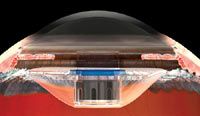FDA approves telescope implant
Patients with end-stage, age-related macular degeneration finally may have hope of regaining some of their central vision thanks to the recent FDA approval of a miniature telescope that can be implanted in the anterior segment.
Saratoga, CA-Patients with end-stage age-related macular degeneration (AMD) finally may have hope of regaining some of their central vision, thanks to the recent FDA approval of a miniature telescope that can be implanted in the anterior segment.

"This is a severely visually impaired population," said Chet Kumar, the company's vice president for business and marketing. "Recognizing faces, watching TV, and reading are challenging or impossible. These are patients who won't be driving."
It's not a cure for AMD, Kumar stressed. But, he explained, the magnified image allows patients to function better in social settings, where they now can recognize faces, pour a cup of coffee, and possibly read large-print books or see headlines in a newspaper.
The FDA approved the device July 6, 4 years after an FDA advisory panel voted against it. After additional studies, the ophthalmic device panel unanimously recommended its approval in March 2009. The implant also carries the CE Mark.
Results of the studies, conducted at 28 ophthalmic centers, showed significant improvement in patients' quality of life. One year after implantation, patients' vision improved by 7 to 14 points on seven of eight vision-specific and psychosocial subscales of the National Eye Institute's Visual Function Questionnaire, including general vision, social functioning, and dependency, Kumar said.
In addition, 67% of patients achieved a 3-line or greater improvement in distance visual acuity of the eye with the implant, compared with 13% of eyes without implants. About 25% of eyes with implants achieved a 5-line or greater improvement in visual acuity, compared with 2% of fellow eyes.
Meanwhile, 1.6% of patients eyes with implants lost three lines or more, compared with 3.1% of fellow eyes.
"What the telescope really does is provide essentially an IOL that acts as a low-vision aid for those patients with end-stage macular degeneration when things like [bevacizumab (Avastin, Genentech)] and [ranibizumab (Lucentis, Genentech)] really can't help anymore," said Stephen Lane, MD, Associated Eye Care, Stillwater, MN, who served as the medical moderator during U.S. trials and was a principal investigator.
"It's essentially a very sophisticated and improved low-vision aid for that group of desperate patients who have end-stage macular degeneration, whose vision can't be helped in any other way," Dr. Lane said.